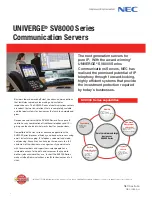
IP
Name Resolving
6-6
To display the subnet mask, use the
Show IP
command.
Figure 6-11:
Show IP Output
The SCS will not change the subnet mask once it is set. If the SCS IP address is changed to a different class,
for example, from a class B to a class C address, the subnet mask will remain a class B address.
The SCS supports
CIDR
(classless routing). CIDR allows Internet Service Providers (ISPs) to group blocks
of class C networks into larger networks. Your ISP will provide you with the appropriate subnet mask. If
you enter a CIDR subnet mask with the
Set/Define IP Subnet
command, the SCS will display a reminder
that classless routing is being used.
Figure 6-12:
Using Classless Routing
6.2.1 Length of Subnet Masks
Variable length subnet masks divide networks into subnetworks of different sizes. For example, if network
128.1.0.0 used variable length subnet masks, the subnet 128.1.4.0 might have subnet mask 255.255.255.0,
and subnet 129.1.224.0 might have subnet mask 255.255.255.240.
For the SCS to function properly, all subnetworks within a particular network must use the same subnet
masks even if each network has a subnet mask of a different length.
6.3 Name Resolving
TCP/IP hosts generally have an alphanumeric host name, such as athena, as well as a numeric IP address,
such as 192.0.1.35. As a text host name may be easier to remember than an IP address, users may use this
name to refer to the host during a Telnet connection attempt.
Network hosts do not understand alphanumeric (text) host names. When a text name is used, the SCS must
translate it into its corresponding IP address. The translation process is called
name resolution
.
To resolve a name, the SCS can use one of two resources: its local name table or the Domain Name Service
(DNS). For example, suppose user Bob wishes to telnet to athena.com. The SCS first consults its local host
table; if the name doesn’t exist, the SCS attempts to resolve the name using the DNS. If the name cannot be
resolved, Bob must enter the IP address in order to access the host.
Some host names and IP addresses are added to the local host table by rwho packets, periodically
broadcasted by UNIX hosts that support the rwho protocol. If addresses are not learned from rwho packets
and DNS is not available, hosts may be manually added to the table. See
Adding Hosts to the Host Table
on
page 6-7 for instructions.
To use the DNS, the SCS must know the IP address of the DNS server.
Local>> SHOW IPSCS Version B1.1/102int(951128)
Name:
DOC_SERVER
Hardware Addr: 00-80-a3-0b-00-5b
Uptime:
1 Day
22:49
IP Address: 192.0.1.221
Subnet Mask:
255.255.255.0
Local>> DEFINE IP ADDRESS 192.0.1.1
Local>> DEFINE IP SUBNET 255.255.240.0
%Info: Supernet (CIDR) mask set.
Summary of Contents for SCS
Page 14: ...xii ...
Page 171: ...Modem Sharing Examples 10 6 ...
Page 314: ...Command Reference Service Commands 12 110 ...
Page 403: ...Show 802 11 Errors Rightmost Number B 5 00000002 Internal error 00000001 Internal error ...
Page 424: ...Index 13 ...
















































